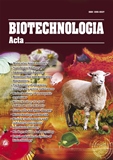ISSN 2410-7751 (Print)
ISSN 2410-776X (Online)

Biotechnologia Acta V. 18, No. 4, 2025
P. 60-67, Bibliography 13 , Engl.
UDC: 678.552
doi: https://doi.org/10.15407/biotech18.04.060
Full text: (PDF, in English)
REINFORCING STARCH BIOPLASTICS WITH AGRICULTURAL WASTE
M.Y. Kozar, O.A. Korneliuk
Faculty of Biotechnology and Biotechnics of the National Technical University of Ukraine
“Igor Sikorsky Kyiv Polytechnic Institute”
Aim. The study was purposed to find alternative reinforcing fillers for the modification of starchbased
bioplastics using agricultural waste.
Materials and Methods. The visual analysis method was used to compare the characteristics of materials with different types of fillers. The influence of various kinds of fillers on the mechanical properties and structure of starch-based bioplastics was evaluated. The study used corn starch according to the DSTU 3976-2000 standard and five different types of agricultural waste as fillers to modify biodegradable plastics. The method of manufacturing the bioplastics included preparing a 10% starch solution, mixing it with other fillers, heating the suspensions to 90 °C, and drying the resulting solutions at 60 °C, depending on the type of filler.
Results. The most successful options were those using technical cellulose fiber and sunflower seed husks compressed into granules. The obtained materials based on these fillers demonstrate better mechanical properties and better shape retention compared to starch-based materials without fillers. The optimal particle size was found to be in the range of 0.03-0.06 mm.
Conclusions. It can be concluded that agricultural vegetable waste has a high potential as an effective filler for starch-based bioplastics, which will significantly reduce the cost of biomaterials and xpand the scope of their use, making them more accessible for a wide range of applications.
Key words: bioplastics, agricultural waste, reinforcing fillers, starch, properties.
© Palladin Institute of Biochemistry of the National Academy of Sciences of Ukraine, 2025
References
1. Ranakoti, L., Gangil, В., Mishra, S.. K., Singh, Т., Sharma, S., Ilyas, R.A. (2022). El-Khatib S. Critical Review on Polylactic Acid: Properties, Structure, Processing, Biocomposites, and Nanocomposites. Mater. 15(12), 4312. https://doi.org/10.3390/ma15124312
2. ANALIZ RYNKU PLA (POLILAKTYD) TA PBAT (POLIMER) UKRAINY. (2021) [Electronic resource] Pro-Consulting – Resource ccess mode: https://pro-consulting.ua/ua/issledovanie-rynka/analiz-rynka-pla-polilaktid-i-pbat-polimer-ukrainy-2021-god
3. Stasiškienė, Ž., Barbir, J., Draudvilienė, L., Chong, Z., Kuchta, K., Voronova, V., Leal Filho, W. (2022). Challenges and Strategies for Bio-Based and Biodegradable Plastic Waste Management in Europe. Sustainability. 14(24), 16476. http://dx.doi.org/10.3390/su142416476
4. Costa, A., Encarnação, T., Tavares, R., Todo Bom, T., Mateus, A. (2023). Bioplastics: Innovation for Green Transition. Polymers. 15(3), 517. https://doi.org/10.3390/polym15030517
5 Holub, N. B., Shchurska, K. O., Kuzminskyi, Ye. V.(2021). Biomass Laboratory Workshop: a study guide. Kyiv, 76 p. (In Ukrainian).
6. DSTU 3976-2000 Corn Starch Dry. Specifications. With amendment No. 1 (IPS № 12-2013) and correction (IPS № 11-2000) (2013). [Electronic resource]. Resource access mode: https://online.budstandart.com/ua/catalog/doc-page.html?id_doc=70422. (In Ukrainian).
7. Safitri, A., Hidayati, H., Evi ,Y. (2022). The role of various plastisizers and fillers additions in improving tensile strength of starch-based bioplastics: A mini review. IOP Conference Series: Earth and Environmental Science. 1115(1), 012076. https://doi.org/10.1088/1755-1315/1115/1/012076
8. Mohammed, A,A.B.A., El-Bakry, A., Salama, H.E., Khalil, H.A. (2022). Corn: Its Structure, Polymer, Fiber, Composite, Properties, and Applications. Polymers. 14(20), 4396. https://doi.org/10.3390/polym14204396
9. Cui, X., Zhang, B., Li, Y., Wang, L. (2019). Pelletization of Sunflower Seed Husks: Evaluating and Optimizing Energy Consumption and Physical Properties by Response Surface Methodology (RSM). Processes. 7(9), 591. https://doi.org/10.3390/pr7090591
10. De'Nobili, M.D.M., Segatto, M. L., Lajolo, F.M. (2021). Sunflower (Helianthus annuus L.) Seed Hull Waste: Composition, Antioxidant Activity, and Filler Performance in Pectin-Based Film Composites. Frontiers in Nutrition. Vol. 8. https://doi.org/10.3389/fnut.2021.777214
11. Ali, A., Asif, M., Zhang, H., Chen, L. (2017). Preparation and characterization of starch-based composite films reinforced by corn and wheat hulls. Journal of Applied Polymer Science. 134(32), 45159. https://doi.org/10.1002/app.45159
12. Enawgaw, H., Edessa, D., Gebre-Mariam, T. (2023). Multiple Utilization Ways of Corn By-Products for Biomaterial Production with Bio-Refinery Concept; a Review. Materials Circular Economy. 5(1). https://doi.org/10.1007/s42824-023-00078-6
13. Omar, F.N., Hassan, E.S., El-Wakil, N.A. (2022). Starch-based composite film reinforcement with modified cellulose from bamboo for sustainable packaging application. Materials Today Communications. Vol. 33, 104392. https://doi.org/10.1016/j.mtcomm.2022.104392

